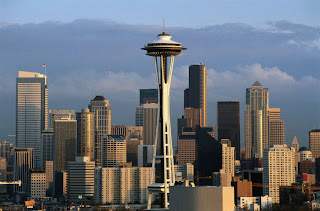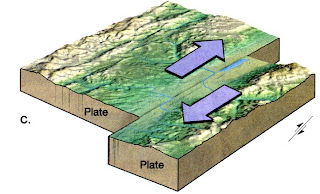My journey has come to a close. After my stop in Bakersfield I drove home to Seattle. It seems a little plain after the many exotic places I visited during my exploration of the many plate boundaries on the planet Earth, but it is definitely good to be home. I hope you have enjoyed my tour, maybe I'll do another one again someday!
Monday, May 13, 2013
Stop Four, Transform!
I'm almost home. I've arrived in the sunny city of Bakersfield, California to explore the final type of plate boundary. Transform boundaries are caused by two plates that are not colliding, but just sliding past each other. Here, the North American and Pacific plates are touching, causing what is called the San Andreas Fault. For a transform boundary to occur, the plates need to be moving in opposite directions. Here, the Pacific Plate, which includes Southern California, is headed Northwest. The rest of the continental USA is on the North American Plate, which is going Southeast. Earthquakes are extremely common along transform boundaries. In 1952, there was a magnitude 5.8 earthquake, and there was also a magnitude 5.4 earthquake late in 2012. However, transform boundaries do not cause volcanoes, so this part of California is free from volcanic activity. Below is a diagram of transform boundaries, although they are fairly easy to understand.
In case you are thinking of also visiting, here's my hotel room with the view in the background. It's very nice.
Sunday, May 12, 2013
Stop Three, Divergent!
This whole traveling-the-world thing is a lot more tiring than you might think. After I left Nepal I got on an extremely long plane ride to Brazil, where I had just enough time to grab some delicious airport food before getting on another plane out to the tiny island of Ascensión in the middle of the Atlantic Ocean. Ascensión is barely 34 square miles, and is extremely remote. I even had to apply to visit! The reason I'm here is because it is one of the closest locations to a major divergent boundary, the Mid-Atlantic Ridge. Divergent boundaries are caused by two plates moving away from each other, oftentimes on the ocean floor. These boundaries have rift valleys, which are valleys at the center of a mid-ocean ridge. The ridges are caused because the plates are moving away from each other, allowing molten rock to force its way up and then cool into new oceanic crust. Below you can see a diagram of this. There are quite a lot of earthquakes associated with divergent boundaries. Here on Ascensión there was a 5.3 magnitude earthquake in early January, and there can be over a dozen earthquakes annually. The ridge is technically made up of dozens of volcanoes, but they are all underwater. However, Ascensión is in fact a volcanic island, meaning it is actually like the top of a giant underwater mountain!
I'm going to miss it here.
Thursday, May 9, 2013
Stop Two, Collision!
Boy, I am jetlagged! I've just gotten off my flight in Kathmandu, the capital of Nepal. I am here to explore a different kind of plate boundary. Collision occurs when an oceanic plate completely subducts under a continental plate, and another continental plate smashes into it (the first continental plate). Since they are close to the same density, neither can go under the other like during subduction. Instead, they press together, fusing into one bigger plate and causing a mountain range to form along the fault line. You've probably heard of the Himalayan Mountains before, the tallest range in the world. They were formed by the subcontinent of India crashing into the continent of Eurasia. India is still pushing north towards China and Russia, moving at about 5 centimeters per year, which means the Himalayas are still slowly getting taller. There are no volcanoes in the Himalayas, but large earthquakes are fairly common. Usually there's at least 2 or 3 per year. In fact, there was a level 6.9 earthquake just 2 years ago in 2011, so I'd better be careful! Here are two pictures, the one on the top shows how collision works and the one on the bottom is a picture a man I met in town showed me from when he climbed Mt. Everest. Maybe someday I'll be able to do the same!
Monday, May 6, 2013
Stop One, Subduction!
I haven't actually gone anywhere new yet. That's because I grew up near a major fault line here in Seattle! The plate of Juan de Fuca is slowly subducting under the major North American plate off the coast of the Olympic Peninsula in Washington State. This means that the Juan de Fuca plate and the North American plate have collided, and the Juan de Fuca plate is more dense so it is forced underneath. We are quite overdue for a major earthquake, in fact. There hasn't been one big enough to cause any serious damage since 1965, although there was a magnitude 6.8 earthquake in 2001 but it didn't cause a ton of damage. The most recent big volcanic eruption was in 1980, when Mt. St. Helens exploded. Explosions aren't common around here, but they are devastating when they do happen. There are a lot of volcanoes around the Seattle area, almost every mountain in the Cascade Range is a volcano. Mt. Rainier, Mt. St. Helens, and Mt. Baker to name a few. The actual fault line isn't visible, since it is underwater, but it is still amazing to look out over the waves and think about what could happen at just about any time.
Introduction
Hello! It is my first year out of high school here in Washington state and I am taking a gap year to tour the world's greatest fault lines before heading off to college. I am going alone, but who knows who I might meet up with along the way? It will be an exciting journey and I will do my best to keep you updated.
Subscribe to:
Comments (Atom)








